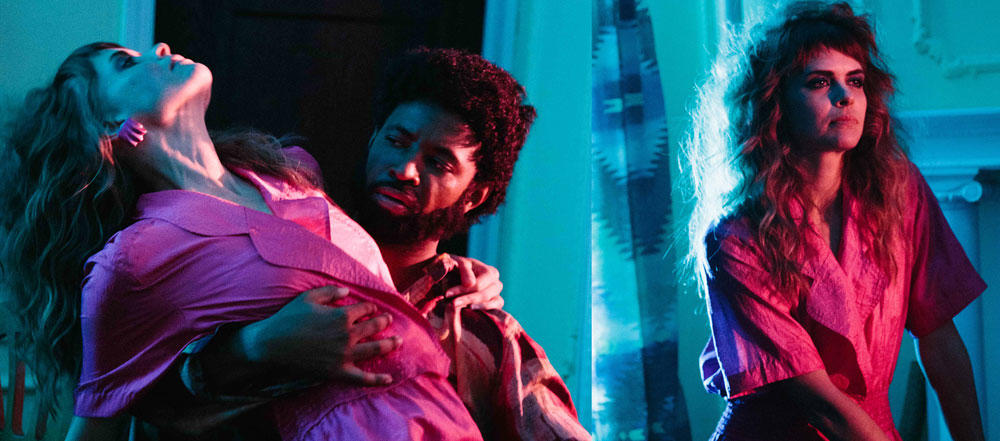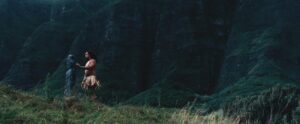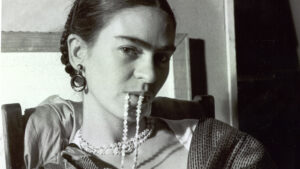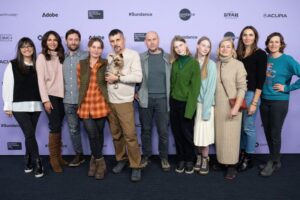Lily Baldwin and Saschka Unseld on set and dancing in a test shoot.
Lily Baldwin
I didn’t do film school. I was a dancer and started making raw stop-motion shorts when touring with David Byrne. After 150 shows, I came to realize that dance enabled people to understand the music. Unsure what the “strange moves” meant, dance gave them permission to feel something they couldn’t necessarily fit into words.
Then is when I first felt the compulsion to turn the electricity of a live performance into an object that could transcend borders, language, and endure time. I turned my hard knock dancer-work-ethic into teaching myself how to edit with stills I’d shot (after a year I realized using a mouse made all the difference). ’Twas pure play—I wasn’t even sure what the “it” of it was supposed to be.
I’ve built this manifesto of sorts that guides my work: Everyone speaks body, it’s a universal alphabet. I define this “visceral cinema” with articulate bodies in space in relationship to a lens. Dance isn’t always a virtuosic “pow”; it’s about bodies that are aware of their edges and use their range. Bodies can’t lie. They are the subtext of us—it’s a subterranean language usually too shy to come out.
Bodies speak nuance and contradiction that get lost when spoken. The clincher is fitting a body inside a lens—a practice that is significantly more crafted than grabbing footage of a crazy-cool body. I think it’s a balance of these: Proximity to lens, distinct performance focus, a breathing handheld camera, knowing when/not to crop a body and lock frame, editing as a rhythm tool (cutting on action, thank you Maya Deren), and sound/music as sub-protagonist and dialogue.
The final convergence shouldn’t be possible in real life. “Gesamtkunstwerk,“ meaning “total work of art,“ is my favorite word, and a wink to The Ballet Russe.
Co-Directing: Where Differences Unite
A couple years ago my friend Saschka Unseld (director/technologist) asked me to make something with dance. I was trying to turn the “flattie” into a kinetic playground, so the prospect of having 360 degrees to mess around with was enticing. I could use my years of performing in unconventional spaces and get rid of the proscenium box that now seemed stuck on a wall. We’ve both always edited our own work and agree that nothing is ever completed. He’s a renowned director, cinematographer, and tech maven (the latter not being my forte). We embraced our differences, jumped off our respective cliffs, and trusted that our mutual rigor would spit us out somewhere. We applied and were accepted into the Sundance Institute Jaunt VR Residency.

This collaboration has been striking. It has enabled me to indulge in imagination without needing to know how to practically realize the fantasy. I play with the parameters of performance and narrative expectation. Saschka is a poet with technology and uses it to capture a distinct human tenderness. He moves like a dancer, engaging his tools like I’ve trained my skeleton. We began collaborating by dancing together – him, as his camera, with me. It’s a unique banter, our unique perfectionisms moving through space. We cantilever off our perspectives, pick up where the other drops off, and take different paths to arrive at the same place. It’s an intuitive collision.
Carob Is Not Chocolate, and VR Is Not Film
What’s disarming (and therefore exciting) about VR, is that we’re asking the viewer to silently enter and intimately witness a world they don’t have much control over (yet). This medium’s power is not about titillating the viewer with a rush of endorphins — we all know adapting film to VR is a mistake. The potency of VR is combining the intensity of immersion with all the tech limitations, and then using these as tools to articulate something that couldn’t exist in any other medium — and should absolutely not be possible in real life.

What Is Story in VR?
We both wrestle with linearity. Real life happens in simultaneous layers, which is how we experience time and therefore story. Creating in 360 degrees space was a relief, and has left us thinking of story in terms of “slices of life.”
Saschka strongly felt we should remove all filmmaking protocol from our process. He slowed down our script into a series of “peak moments of being” that were strung in a bold tableau. I think of it as walking through a museum and stepping inside a series of paintings (each one a complete world) on the wall.
VR demands that users feel culpable, feel responsible, feel powerful, feel alone, and feel close. What is a story that uses this alphabet? These tenets dictate our story experience. Time plays differently because there’s so much to see! Because you’re intimate with the environment, little things become epic. Directing in VR is its own muscle, one we’re exploring and training.
Limitations Are Portals for Discovery
My uncle is hard of hearing and he has the most amazing sense of smell. There’s something about having less of one thing, that mandates solving in unexpected ways. I’m a sucker for detail and frustrated by the “fuzzy” picture in VR.
After a test shoot, we decided we couldn’t lose the subtle intimacy of our breathing dancers, Joanna Kotze, Amari Cheatom, and Marni Wood, as they moved from the ‘70s through 2046. So we decided dance had to express emotion graphically. Specified fingers in space made all the difference. Colored light would imbue the emotional details lost in their faces.
Inside the crafted costume and production design, reflective fabrics with bold patterns would define the character of a body, bold architectural shapes in the room and strong color shifts would best show time passing.

Rigorous Mistakes Are Innovations
Authentic creativity and innovation come from not having rules and not knowing what things are called. Too much identification keeps us confined to knowing what things should be. When I fall onstage and fuck up, it presents a new choice. (First thing is to keep a straight face and never look like you didn’t mean it.) This impromptu problem-solving and rigorous commitment to follow-through is my background, and we’re finding it’s perfect for VR.
On set my freshness to the space had me proposing wild “What if?” and “Can we…?!” questions. Saschka adamantly protected our creative discovery saying that anything that “wasn’t supposed to work,” we’d ignore. “There are no rules, anyone who says differently is jumping the gun,” he said. As our previous experiments had proved, we could move the camera and not make the viewer nauseous. It was more complex than tracking a “fixed focal point” — we found the key is creating a physical connection between the camera/viewer and the subject.
I danced with Saschka, and there happened to be a camera between us. Fast cuts? Jump cuts? Frantic changes in pace? It’s all possible, it’s just a force that needs to be properly wielded. The conversation is too often between technology and art. We’re talking about technology and body. We want to use technology to move into uncharted areas that make us reckon with our mortality. Our motto: If we fail, if this ends up a disaster, let’s at least fail upwards.

We’ve thrown caution to the wind, and there’s nothing shy about Through You. We dive head on into a never-ending love story that will play cyclically, hitting the peak moments of intimacy, betrayal, loss, aging, the passing of time — only to be engulfed in flames and then reborn again under water. It’s a racy, bold, and undeniably human experience that pushes the power of immersion and dares us to have a body that loves, feels pleasure, and feels loss.
We worked intensely with our DP and longtime collaborator Dagmar Weaver-Madsen – a fierce maker in her own right – and she held us to task, grounded our ideas in practicality, and proposed bold DIY ideas to solve curveballs. She pushed us hard and kept the production glued together with the expertise of Brooke Chapman, our camera supervisor who wielded Jaunt’s incredible camera. It was a dream team. None of Through You would exist without our team’s incredibly hard work.
It’s a hot moment, this VR thing. As a dancer first, it’s a space where I thrive and where I don’t have to be an expert – I just get to be rigorously curious. I feel like I’m a detective and we’re all on a wicked-good scavenger hunt.
This endeavor has been an intricate mechanism at work lead by Shruti Ganguly, Fictionless and Elliott Whitton with the generous support of Yelena Rachitsky and Column Slevin at Oculus and Tom Vance at Jaunt. And of course the thoughtful brainstorming with Ruthie Doyle, Kamal Sinclair and Michelle Satter through the Sundance Residency.
Everyone kept pushing us to trust ourselves. Through You—like a performance that has us all onstage together needing to trust each other’s weight—has been a collective effort requiring blind faith, that’s had us doing things we’ve never done. Excitement is afoot.
Final Thoughts
With such polarizing fear shaping our climate, we’ve called our choices into question. It’s a privilege to do what we do. (“Artist” makes us cringe – we think of ourselves as “lookers,” “finders” and “makers.”) What can we do about what’s happening in our world now? We’ve landed here – how can 360 immersive degrees wake up a body? When we literally feel ourselves and all that VR can do (way more than we think), we remember our impact: we are responsible, we make a difference.




